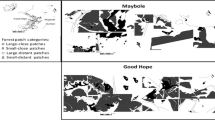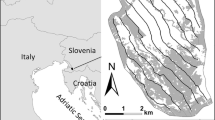Abstract
The few remaining Afromontane forest fragments in northern Ethiopia and the surrounding degraded, semiarid matrix form a habitat mosaic of varying suitability for forest birds. To evaluate the effect of recent land rehabilitation efforts on bird community composition and diversity, we studied bird species distributions in ten small forest fragments (0.40–20.95 ha), five grazing exclosures (10-year-old forest restoration areas without wood extraction and grazing livestock) and three grazed matrix sites during the rainy season (July–October 2004) using 277 one-hour species counts. Based on the distribution pattern of 146 bird species, sites were assigned to one of three bird communities (birds of moist forest, dry forest or degraded savanna), each occupying a well-defined position along an environmental gradient reflecting decreasing vegetation structure and density. All three communities were representative of the avifauna of Afrotropical Highland open forest and woodland with a high proportion of invasive and competitive generalist species (31%). Apart from these, exclosures shared more species with forest fragments (20%) than did the grazed matrix (5%), indicating local ecosystem recovery. By increasing habitat heterogeneity, exclosures have the potential to enhance landscape connectivity for forest birds and are, therefore, an effective instrument for conserving species in a fragmented landscape. However, 52 bird species (36%) occurred exclusively within forest patches and many forest birds that use exclosures are unlikely to maintain viable populations when forest fragments disappear, particularly as forest fragments may be a critical resource during the hot dry season. This highlights the high conservation value of small isolated forest fragments for less tolerant, forest-limited and/or biome-restricted species.



Similar content being viewed by others
Abbreviations
- TSC:
-
Timed species count
- MRPP:
-
Multiresponse permutation procedure
- NMDS:
-
Non-metric multidimensional scaling
References
Abebe MH, Oba G, Angassa A, Weladji RB (2006) The role of area enclosures and fallow age in the restoration of plant diversity in northern Ethiopia. Afr J Ecol 44:507–514
Aerts R (2007) Church forests in Ethiopia. Front Ecol Environ 5:66–66
Aerts R, Wagendorp T, November E, Behailu M, Deckers J, Muys B (2004) Ecosystem thermal buffer capacity as an indicator of the restoration status of protected areas in the northern Ethiopian highlands. Restor Ecol 12:586–596
Aerts R, Van Overtveld K, Haile M, Hermy M, Deckers J, Muys B (2006) Species composition and diversity of small Afromontane forest fragments in northern Ethiopia. Plant Ecol 187:127–142
Antongiovanni M, Metzger JP (2005) Influence of matrix habitats on the occurrence of insectivorous bird species in Amazonian forest fragments. Biol Conserv 122:441–451
Avery M, Leslie R (1990) Birds and forestry. T. & A.D. Poyser Ltd., London
Bhagwat SA, Rutte C (2006) Sacred groves: potential for biodiversity management. Front Ecol Environ 10:519–524
Bibby CJ (2004) Bird diversity survey methods. In: Sutherland WJ, Newton I, Green RE (eds) Bird ecology and conservation. A handbook of techniques. Oxford University Press, Oxford, pp 1–15
Blankespoor GW (1991) Slash-and-burn shifting agriculture and bird communities in Liberia, West Africa. Biol Conserv 57:41–71
Castellón TD, Sieving KE (2006) An experimental test of matrix permeability and corridor use by an endemic understory bird. Conserv Biol 20:135–145
Colwell RK (2006) EstimateS: Statistical estimation of species richness and shared species from samples. Version 8. Persistent <http://purl.oclc.org/estimates>
Dufrêne M, Legendre P (1997) Species assemblages and indicator species: the need for a flexible asymmetrical approach. Ecol Monogr 67:345–366
Fischer J, Lindenmayer DB (2002) Small patches can be valuable for biodiversity conservation: two case studies on birds in Southeastern Australia. Biol Conserv 106:129–136
Freeman SN, Pomeroy DE, Tushabe H (2003) On the use of timed species counts to estimate avian abundance indices in species-rich communities. Afr J Ecol 41:337–348
Graham CH, Blake JG (2001) Influence of patch- and landscape-level factors on bird assemblages in a fragmented tropical landscape. Ecol Appl 11:1709–1721
Hames RS, Rosenberg KV, Lowe JD, Dhondt AA (2001) Site reoccupation in fragmented landscapes: testing predictions of metapopulation theory. J Anim Ecol 70:182–190
Kupfer JA, Malanson GP, Franklin SB (2006) Not seeing the ocean for the islands: the mediating influence of matrix-based processes on forest fragmentation effects. Global Ecol Biogeogr 15:8–20
Lees AC, Peres CA (2006) Rapid avifaunal collapse along the Amazonian deforestation frontier. Biol Conserv 133:198–211
Lens L, Van Dongen S, Norris K, Githiru M, Matthysen E (2002) Avian persistence in fragmented rainforest. Science 298:1236–1238
Manu S, Peach W, Cresswell W (2007) The effects of edge, fragment size and degree of isolation on avian species richness in highly fragmented forest in West Africa. Ibis 149:287–297
McCune B, Mefford MJ (1999) PC-ORD 4.0 for Windows. Multivariate analysis of ecological data. MjM Software, Gleneden Beach
Mekuria W, Veldkamp E, Haile M, Nyssen J, Muys B, Gebrehiwot K (2007) Effectiveness of exclosures to restore degraded soils as a result of overgrazing in Tigray, Ethiopia. J Arid Environ 69:270–284
Mengistu T, Teketay D, Hulten H, Yemshaw Y (2005) The role of enclosures in the recovery of woody vegetation in degraded dryland hillsides of Central and Northern Ethiopia. J Arid Environ 60:259–281
Raman TRS (2006) Effects of habitat structure and adjacent habitats on birds in tropical rainforest fragments and shaded plantations in the Western Ghats, India. Biodivers Conserv 15:1577–1607
Renjifo LM (2001) Effect of natural and anthropogenic landscape matrices on the abundance of subandean bird species. Ecol Appl 11:14–31
Saunders DA, Hobbs RJ, Margules CR (1991) Biological consequences of ecosystem fragmentation – a review. Conserv Biol 5:18–32
Sekercioglu CH (2007) Conservation ecology: area trumps mobility in fragment bird extinctions. Curr Biol 17:909–909
Sekercioglu CH, Ehrlich PR, Daily GC, Aygen D, Goehring D, Sandi RF (2002) Disappearance of insectivorous birds from tropical forest fragments. Proc Natl Acad Sci 99:263–267
Sekercioglu CH, Loarie SR, Oviedo Brenes F, Ehrlich PR, Daily GC (2007) Persistence of forest birds in the Costa Rican agricultural countryside. Conserv Biol 21:482–494
Siegel S, Castellan NJ (1988) Nonparametric statistics for the behavioral sciences. McGraw-Hill, New York
Skowno AL, Bond WJ (2003) Bird community composition in an actively managed savanna reserve, importance of vegetation structure and vegetation composition. Biodivers Conserv 12:2279–2294
Thiollay J-M (2006) Large bird declines with increasing human pressure in savanna woodlands (Burkina Faso). Biodivers Conserv 15:2085–2108
Tilahun S, Edwards S, Berhan Gebre Egziabher T (1996) Important bird areas of Ethiopia. A first inventory. Ethiopian Wildlife and Natural History Society, Addis Ababa
Trager M, Mistry S (2003) Avian community composition of kopjes in a heterogeneous landscape. Oecologia 135:458–468
Tubelis DP, Cowling A, Donnelly C (2004) Landscape supplementation in adjacent savannas and its implications for the design of corridors for forest birds in the central Cerrado, Brazil. Biol Conserv 118:353–364
Turner IM (1996) Species loss in fragments of tropical rain forest: a review of the evidence. J Appl Ecol 33:200–209
Urban E, Brown L (1971) A checklist of the birds of Ethiopia. Addis Ababa University Press, Addis Ababa
van Heezik Y, Seddon PJ (1999) Effects of season and habitat on bird abundance and diversity in a steppe desert, northern Saudi Arabia. J Arid Environ 43:301–317
Van Houtan KS, Pimm SL, Halley JM, Bierregaard RO, Lovejoy TE (2007) Dispersal of Amazonian birds in continuous and fragmented forest. Ecol Lett 10:219–229
Van Perlo B (1995) Birds of Eastern Africa. HarperCollinsPublishers, London
Wassie A, Teketay D (2006) Soil seed banks in church forests of northern Ethiopia: Implications for the conservation of woody plants. Flora 201:32–43
Wethered R, Lawes MJ (2003) Matrix effects on bird assemblages in fragmented Afromontane forests in South Africa. Biol Conserv 114:327–340
Wilson JB (1999) Guilds, functional types and ecological groups. Oikos 86:507–522
Wilson CJ, Reid RS, Stanton NL, Perry BD (1997) Effects of land use and Tsetse fly control on bird species richness in southwestern Ethiopia. Conserv Biol 11:435–447
Acknowledgements
We thank Cagan Sekercioglu and the reviewers Mike Lawes and Will Cresswell for providing valuable insights and helpful comments on this manuscript at various stages. This research was supported by the Flemish Interuniversity Council (VLIR-UDC) and the K.U. Leuven Research Fund.
Author information
Authors and Affiliations
Corresponding author
Appendix
Appendix
Rights and permissions
About this article
Cite this article
Aerts, R., Lerouge, F., November, E. et al. Land rehabilitation and the conservation of birds in a degraded Afromontane landscape in northern Ethiopia. Biodivers Conserv 17, 53–69 (2008). https://doi.org/10.1007/s10531-007-9230-2
Received:
Accepted:
Published:
Issue Date:
DOI: https://doi.org/10.1007/s10531-007-9230-2




